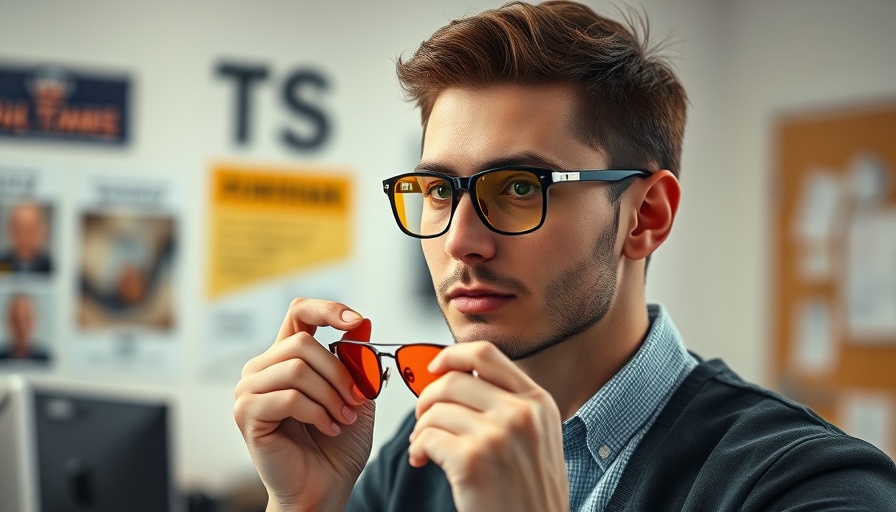
Understanding Blue Light Glasses: What You Need to Know
There has long been a debate around blue light glasses: Are they effective, or simply a clever marketing gimmick? As we navigate a world filled with screens—from our phones to our laptops—the question becomes increasingly relevant. In this article, we will break down the different types of blue light glasses, examine their potential benefits, and dispel some persistent myths that have emerged in this context.
In the video 'Blue Light Glasses: Scam or Science?', the discussion dives into the effectiveness of blue light glasses, exploring key insights that sparked deeper analysis on our end.
The Science Behind Blue Light
Blue light is part of visible light and is emitted by various sources, including the sun, digital screens, and even indoor LED lighting. Its short wavelengths make it energizing, which is why it can be both a blessing and a burden. While blue light can enhance alertness during the day, excessive exposure, particularly in the evening, can disrupt sleep patterns. Companies rushed to produce blue light blocking glasses, claiming that these tools could help mitigate the discomfort arising from prolonged screen time.
Types of Blue Light Glasses You Should Know About
Until recently, there was no standardized classification system for blue light glasses, resulting in a saturated market filled with products of varying effectiveness. However, a new standard known as HEV (High Energy Visible) lenses has emerged, categorizing these glasses based on the wavelengths they block:
- HEV1: Blocks wavelengths from 455 to 500 nm, specifically targeting blue turquoise light that affects sleep cycles.
- HEV2: Blocks wavelengths between 400 and 455 nm, which can lead to oxidative stress on the retina.
- HEV3: Blocks wavelengths from 380 to 400 nm, closely bordering on UV light.
Selecting glasses based on these classifications will help consumers make informed choices instead of relying on broad marketing claims.
Eye Strain vs. Blue Light Glasses: The Myth Explored
With the rise of remote work, many consumers are eager for solutions to digital eye strain. Eye strain symptoms can include soreness, fatigue, and headaches, leading many to believe that blue light glasses are the answer. However, substantial clinical evidence doesn’t support the idea that these glasses provide significant relief from eye strain. Most studies reveal that common eye strain is largely related to dry eyes caused by decreased blinking while using screens, rather than the blue light itself.
Nonetheless, some people report feeling a reduction in eye strain when wearing blue light glasses. Why? It could be due to psychological effects—like color perception—or the anti-reflective technology many of these glasses possess, which can reduce glare from screens. Understanding this will help consumers manage their expectations.
The Sleep Cycle Connection
For those worried about sleep disturbances due to blue light, wearing HEV1 glasses in the evenings might be beneficial. These glasses filter specific wavelengths known to interfere with melatonin production and sleep cycles. Yet, the broader consensus encourages a balanced approach: reducing overall blue light exposure by adjusting screen settings or dimming indoor lights instead of solely relying on blue light glasses.
Real Solutions for Eye Health Beyond Blue Light Glasses
As interesting as blue light glasses are, they shouldn't be viewed as a catch-all solution. Instead, there are practical steps individuals can take to promote eye health, especially when frequently in front of computers:
- Implement the 20-20-20 rule: Every 20 minutes, look at something 20 feet away for 20 seconds.
- Stay hydrated: Drink plenty of water to help reduce the chances of dry eyes.
- Use artificial tears: These can keep your eyes moist during prolonged screen time.
By employing these strategies, individuals can alleviate eye strain effectively while maintaining their vibrant digital lifestyles.
Conclusion: Should You Invest in Blue Light Glasses?
Ultimately, whether blue light glasses work depends on what you’re looking for. If your primary concern is improving sleep quality, investing in quality HEV1 glasses might offer some benefits during evening hours. However, if combating eye strain is your aim, it’s best to focus on proven methods supported by research, such as taking frequent breaks and ensuring proper hydration.
So, while blue light glasses may not be a magical fix, they could play a useful role in specific scenarios. Educating yourself on these nuances empowers you to make choices that genuinely promote your eye health and overall well-being.
 Add Row
Add Row  Add
Add 




Write A Comment